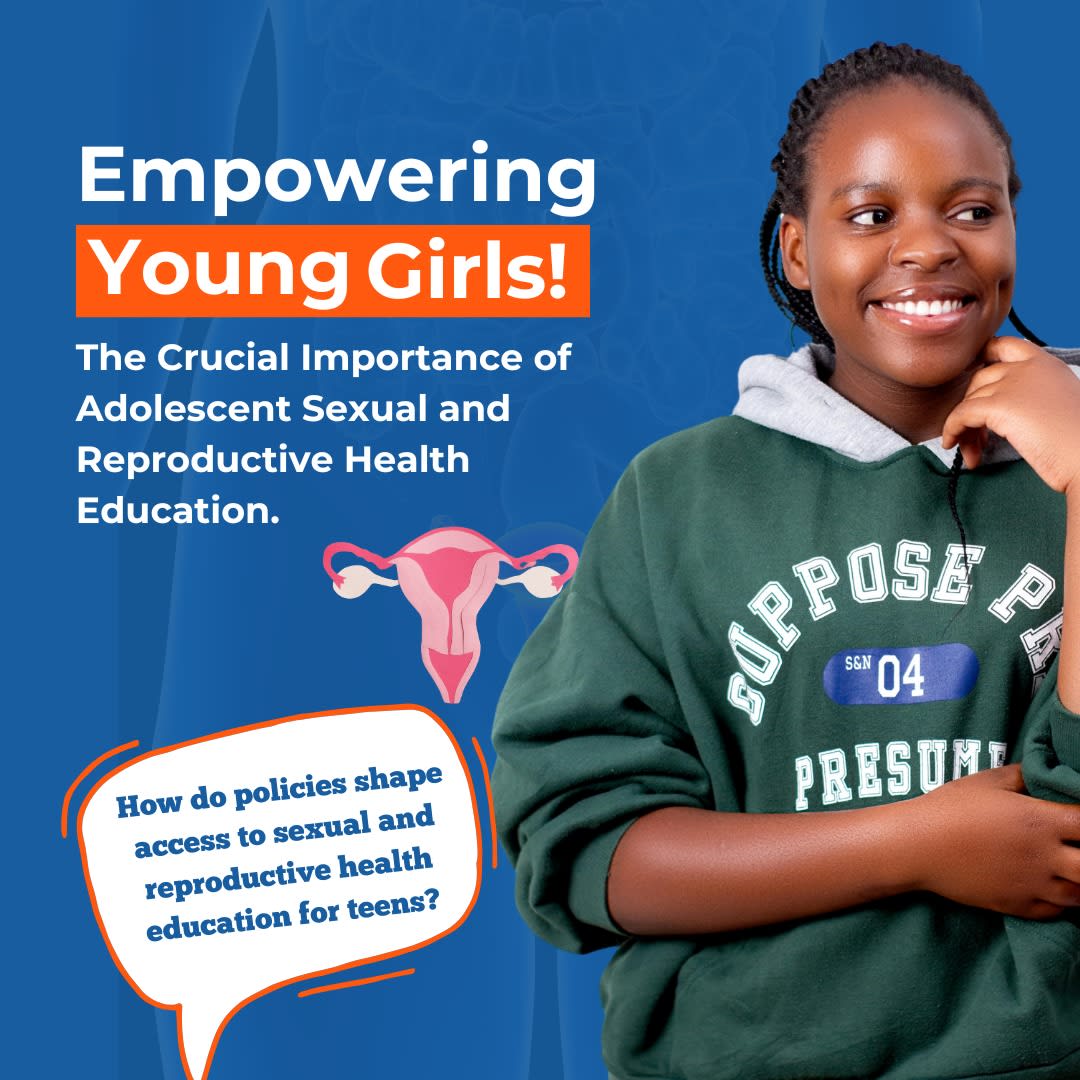EMPOWERING YOUNG GIRLS: The Crucial Importance of Adolescent Sexual and Reproductive Health Education
Adolescence, spanning the ages of 10 to 19, marks a transformative period in the lives of young people. This stage is characterised by several physical and biological changes that often result in a heightened sense of awareness of self and their immediate surroundings. The renowned child psychologist David Elkind refers to this phase as “Adolescence egocentrism.”
The changes however differ in both genders. Boys undergo voice deepening and body transformations, and girls while also undergoing transformation in their bodies experience menarche, their first menstruation. Various cultures welcome adolescents into this journey with different rituals and celebrations. In India, the “Thirandukalyanam“ ceremony marks this milestone, while in Peru, a period of separation known as “Pelazón“ unfolds during the initial three to six months of a girl's menstruation.
This stage demands important conversations around their Sexual and Reproductive Health. The transition to adolescence raises myriad questions in the minds of adolescents, and it is imperative that the responses must extend beyond vague, unsatisfactory explanations to encompass comprehensive information on the changes they are experiencing and what it could mean for them. Notably, in many traditional and cultural families, these celebrations highlight the importance of acknowledging and guiding adolescents through this transformative stage, but it raises questions about the comprehensiveness of these information which are often heavily shaped by culture, values, and norms and varies in different environments.
The significance of Adolescent Sexual and Reproductive Health (ASRH) goes beyond cultural practices; it is a critical facet of public health that directly impacts the well-being of young individuals who constitute a substantial percentage of the Nigerian population. As we explore into the importance of intricate conversations about ASRH education, it becomes even more evident that empowering young girls with comprehensive knowledge is key for their development and overall health.
Kids & Teens Resource Centre “Knowing Series”
As adolescents navigate the complexities of their development, ensuring access to comprehensive sexual and reproductive health education and resources becomes increasingly vital. According to a BMC Health Services research conducted in 2018, despite the recognition of youth-friendly reproductive health services as a way of improving access and utilisation of ASRH services, the needs of these adolescents still do not receive enough attention.
Adolescents and young people are less served when it comes to the right form of education, and this is evident in the number of unintended pregnancies and induced abortion statistics captured in published National Policy on The Health and Development of Adolescents and Young People in Nigeria in 2019. Adolescent girls constituted 31% of the numbers of young people who engaged in induced abortion in the South West region. This suggests a serious problem.
It is also worthy of note and concern, the exclusion of Adolescents living with disabilities from mainstream discussions on Comprehensive Sex Education/Adolescent Sexual and Reproductive Health. The UN’s Disability and Development Report notes lack of resources, attention and the barriers People Living With Disability (PLWD) face in accessing sexual and reproductive health services and information compared to their counterparts. Recognising the need for change, Kids and Teens Resource Centre (KTRC), an NGO based in Ondo State, Nigeria, dedicated to the physical and mental well-being of adolescents and young people, joined in the advocacy for the inclusion of Comprehensive Sex Education in the education curriculum.
Organisations at the forefront of this campaign, including Kids & Teens Resource Centre (KTRC), took proactive measures to fill the gaps in knowledge and awareness. Workshops were organized targeting parents, teachers, and teenagers from selected secondary schools, emphasising the importance of providing adolescents not only with comprehensive but also culturally sensitive information about their reproductive and sexual health. This advocacy extended into the “Knowing Series,” an initiative with objectives to equip young people with knowledge and skills for informed decision-making. The series provides a platform for dialogue with adolescents, addressing their questions about sexual and reproductive health.
KTRC’s impact has extended to more than 50 grassroots schools, delivering a message with the potential to positively transform the lives of adolescents and young people. While commendable, this initiative highlights the ongoing need for increased national-level efforts to address the immediate healthcare needs of adolescents in underserved regions.
The Crucial Role of Policies in Adolescent Sexual and Reproductive Health Education
Policymaking plays an important role in shaping the landscape of any initiative, particularly ones that addresses the unique needs of young girls and women. Robust and inclusive policies not only safeguard the rights of adolescents but also lay the groundwork for fostering education, awareness, and equitable access to healthcare services.
Nationally, Nigeria has made commendable strides by introducing its first National Policy on Adolescent Health in 1995. This move reflects an understanding of the imperative to prioritise the well-being of the growing population and acknowledges the crucial role that a solid policy framework can play. Over the years, this initial policy has undergone revisions, resulting in subsequent National Policies on Health and Action Plans. While these policies articulate commitments to addressing Adolescent Sexual and Reproductive Health (ASRH), their impact remains hindered, particularly at the grassroots level.
The challenge lies in translating policies from paper into impactful implementation. Although policies exist, their practical application, especially at the grassroots level, has been limited. To ensure that information on Adolescent Sexual and Reproductive Health reaches its intended audience, implementation must extend beyond formal policies. It necessitates proactive advocacy and grassroots efforts.
Addressing ASRH requires taking the message directly to the target audience. While hospitals and public health centres provide essential spaces, the message must also penetrate secondary schools—the primary hub for the target age group. KTRC has already taken significant steps in this direction, breaking down the message into easily digestible forms tailored to each environment, but its reach is limited.
For a comprehensive impact, it is crucial that such effort is replicated. The dissemination of information on ASRH should not be confined to institutional spaces; rather, it should permeate the everyday environments where adolescents can be found. This multifaceted approach, combining policy advocacy with grassroots engagement, ensures that the message of Adolescent Sexual and Reproductive Health education not only exists on paper but reaches the communities that need it the most.
Navigating the Present Landscape of Adolescent Sexual and Reproductive Health
The community’s response to the Comprehensive Sex Education initiative spearheaded by KTRC has been diverse, reflecting a spectrum of attitudes. Parents, teachers, and teenagers have showcased varying reactions. Some have embraced the initiative wholeheartedly, acknowledging the pressing need for adolescents to possess the knowledge and skills required for informed decisions about their sexual and reproductive health. However, others remain hesitant, mirroring broader societal attitudes, cultures, norms, and values.
While these initiatives have increased awareness, adolescents still face formidable challenges in accessing accurate information about contraceptives, and other healthcare services. Persistent issues such as early pregnancies, sexually transmitted infections, and inadequate education about menstruation emphasise the urgent need for well-crafted policies. These policies should adopt a holistic approach, unified and culturally sensitive, comprehensively addressing challenges and harmful practices. This includes sexual violence, child marriages, contraception and maternal care for pregnant adolescents, use of hard drugs and mental health.
Furthermore, the policies should adequately capture adolescents living with disabilities and extend beyond the policy stage to aggressive implementation, challenging harmful traditions and cultural stigmas.
21 Feb 2022







